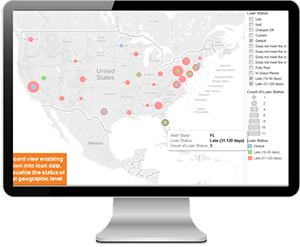SmartCECL
Begin YourCECL Transformation Journey WithSmartCECL
SmartCECL is a highly scalable, fault-tolerant and proven solution to address CECL requirements.Built specificallyto manage CECL complexity ina high performance analytics environment. Centralized and flexible solution to meet dynamic challenges of new accounting standards along with high customizationand advanced financial reporting capabilities.
Forward Looking
Use of forward looking information to calculate reserves. Reserves to be based on expected losses over the life of a loan
Scalable Platform

BigData platform to capture and store high volumes of granular loan level data, customer demographic information
Proven Analytical Methods

Granular data will need to be captured for analytics and newer performance metrics requiring upgrade to data warehouses, IT systems and institutions will have increased functional co-ordination for accurate forecasting of expected losses.
360 Degrees View

of Risk portfolio of lending, drill down views by products, customer groups and individual loans

Know more about CECL
Current Expected Credit Loss model (CECL) is a new accounting standard issued by the Financial Accounting Standards Board (FASB) in June 2016. It replaces the ‘Incurred loss’ model. The financial crisis shaped the need for changing the way banks estimate losses in their ‘Allowance for loan and lease losses’ (ALLL) method.
CECL requires that financial institutions measure expected credit losses with reasonable and supported forecasts. The Incurred Loss model estimated loss on the basis of historical loss data and prevailing current situation.
Why ALLL (Allowance for loan and lease losses) is not good enough?
ALLL was based on “Incurred Loss” which was Backward-looking as they rely primarily on historical information.Credit losses were recognized only once they are considered “probable” and the losses could be estimated. This led to a ‘Time lag’ in how losses are reflected.
Unfortunately, this issue was exposed only during the financial crisis, as this delay in loss recognition meant reserves were insufficient to cover institutions’ growing losses as credit deterioration accelerated
Why should you act on CECL ‘NOW’?
The timelines are tight to implement the CECL measures which involve having its own roadmap, scenarios & modeling which have to be ready to be adopted a few months from now – 2018. It brings with it, its own set of challenges and complexities.

Our Expertise
- Cloud Strategy & Implementation
- DevOps and Quality Eng. Services
- Data Science & Big Data
- AI Management Consulting
- Advanced Analytics
- Custom Application Design
Target Industries
- Financial Services
- Healthcare
- Retail Services
- Insurance
- Automation
- Telecom & Media
Technology Platforms
- Cloud Computing
- Enterprise Applications & Solutions
- Salesforce Development Services